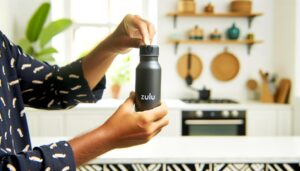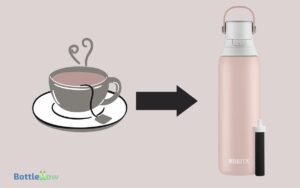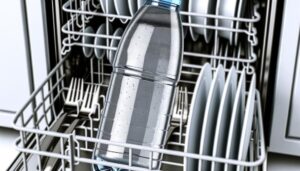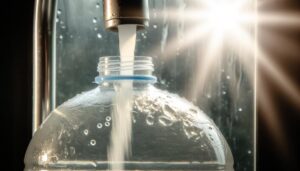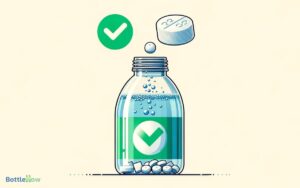Coldest Water Bottle Suction Problem: Solution!
To address suction problems with your Coldest Water Bottle, start by diagnosing common issues like vacuum seal formation and straw blockages.
Confirm the lid isn’t overtightened, check for blockages in the straw, and verify the rubber gasket is properly seated.
Examine the air valve for any obstructions and regularly clean all components, including the lid and straw. A misaligned gasket or a damaged straw can greatly interfere with suction, making it hard to sip.
Simple adjustments and thorough checks can resolve these problems, guaranteeing smooth hydration. For a deeper understanding of troubleshooting, explore further details and solutions.
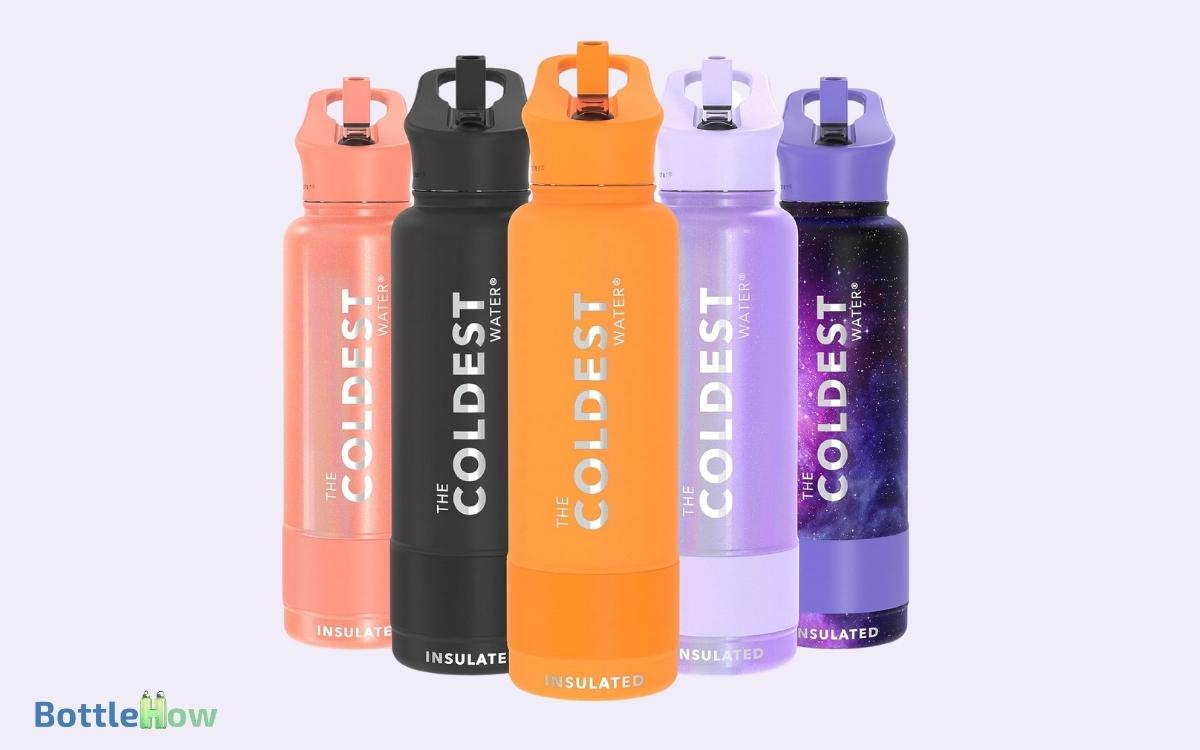
Key Takeaways
Understanding the Suction Issue
When you encounter difficulty sipping from your Coldest Water Bottle, the issue often stems from a vacuum seal created inside the bottle. This vacuum forms when air can’t enter the bottle to replace the liquid you’re consuming.
To diagnose the problem, examine the bottle’s components: the lid, straw, and venting system. Make sure the lid is screwed on securely but not overly tight, as excessive tightening can exacerbate the vacuum issue. Also, inspect the straw for blockages and confirm it’s properly attached.
Common Causes
You’ll often find that suction problems with your Coldest Water Bottle stem from lid seal issues or straw obstructions.
Check for any gaps or wear in the lid’s seal, as even minor imperfections can disrupt proper suction. Also, make sure the straw is clear of debris or blockages that could impede airflow.
Lid Seal Issues
One common cause of lid seal issues in coldest water bottles is the misalignment of the rubber gasket. If the gasket isn’t seated properly, it can create gaps that let air in, compromising the vacuum seal.
You should inspect the gasket for any twists or bends and make sure it’s sitting flat within the lid’s groove.
Another factor could be wear and tear; over time, gaskets can become brittle or stretched. Replace the gasket if you notice any damage.
Additionally, debris or residue on the sealing surfaces can prevent a tight seal. Clean both the gasket and the lid regularly to maintain peak performance.
Addressing these issues can greatly improve the seal and functionality of your coldest water bottle.
Straw Obstructions
A common cause of straw obstructions in coldest water bottles is the accumulation of debris or residue within the straw itself, which can impede proper water flow.
Mineral deposits, leftover beverage particles, or even mold can build up, narrowing the straw’s passage. Regular cleaning with a straw brush can mitigate this issue.
Additionally, inspect the straw for any bends or kinks that might restrict flow. If the obstruction persists, consider soaking the straw in a vinegar solution to dissolve any stubborn residue. Always make sure the straw is thoroughly rinsed to avoid any lingering taste.
Impact on Usability
You’ll notice that the suction problem greatly affects your drinking experience, making it difficult to sip water smoothly.
Additionally, the issue complicates maintenance and cleaning, as trapped air and liquid can cause a buildup of residues.
Addressing these usability concerns requires a methodical approach to identify and rectify the underlying causes.
Drinking Experience Affected
Many users report that the suction problem greatly diminishes the overall drinking experience, making it inconvenient and frustrating to stay hydrated.
You might find that each sip requires excessive effort, disrupting the flow of your activities. This issue often stems from air not flowing smoothly into the bottle, creating a vacuum effect. To mitigate this, you can try loosening the cap slightly to equalize pressure.
However, this workaround isn’t essential for everyone, especially during physical activities where a secure cap is vital.
You may also notice that the suction problem affects the volume of water intake, as you can’t drink as much as you’d like in one go. Addressing this flaw is important for enhancing usability and ensuring hydration efficiency.
Maintenance and Cleaning Issues
Maintaining the Coldest Water Bottle regularly can become a hassle, greatly impacting its usability and overall user experience.
Residue build-up can obstruct the suction mechanism, causing drinking difficulties. You’ll need to disassemble the bottle frequently, which isn’t always straightforward.
Hard-to-reach areas can harbor bacteria, compromising hygiene and safety. Use specialized brushes to clean small parts, ensuring thorough maintenance.
Regularly inspect the seals and gaskets, as wear and tear can lead to leaks. Consider using a vinegar solution to remove mineral deposits.
User Experiences
A significant number of users have reported issues with the suction mechanism in their Coldest Water Bottle, affecting its overall functionality.
Many have noted that the suction becomes inconsistent, which can be frustrating during use. Some users believe the problem arises from design flaws, while others suspect manufacturing inconsistencies. Evaluating these experiences can help identify patterns and potential causes.
| User | Issue | Frequency |
|---|---|---|
| User 1 | Inconsistent suction | Frequently |
| User 2 | Difficult to draw water | Occasionally |
| User 3 | Suction stops entirely | Rarely |
| User 4 | Requires excessive force | Frequently |
Analyzing these reports highlights the need for technical solutions to improve the user experience.
Simple Fixes
Addressing the suction problem in your Coldest Water Bottle can often be achieved with a few straightforward adjustments.
First, make sure the lid’s rubber gasket is properly seated. Misalignment can cause pressure imbalances, leading to suction issues.
Next, check the air valve for obstructions. Small debris can block airflow, preventing smooth drinking. Cleaning the valve with a toothpick or brush can resolve this.
Additionally, try loosening the lid slightly. Over-tightening can create a vacuum seal, making it difficult to drink.
Lastly, ensure the straw isn’t kinked or damaged. A bent straw restricts liquid flow, exacerbating suction problems.
Advanced Solutions
For more persistent suction problems with your Coldest Water Bottle, consider upgrading the air valve to a high-flow variant designed to enhance airflow and mitigate vacuum formation.
This advanced solution addresses the root cause of excessive suction, ensuring a smoother drinking experience.
Evaluate the compatibility of the new air valve with your current bottle model to avoid any mismatches.
| Problem | Solution |
|---|---|
| Frequent suction issues | High-flow air valve upgrade |
| Airflow restriction | Enhanced airflow design |
| Compatibility concerns | Check model compatibility |
In addition, regularly inspect the valve for any blockages or debris that might impede its performance.
Implementing these advanced solutions not only resolves the current issue but also prolongs the lifespan of your water bottle, offering a more reliable hydration tool.
Maintenance Tips
To maintain peak performance of your Coldest Water Bottle, regularly clean all components and inspect for any signs of wear or damage.
Disassemble the bottle and use warm soapy water to clean the cap, straw, and interior. Rinse thoroughly to remove any soap residue.
Check the rubber gasket for cracks or deformation, as this can impact suction. If the gasket shows wear, replace it to guarantee a proper seal.
Examine the straw for blockages and clean it using a straw brush. Regularly lubricate the lid’s threads with food-grade silicone grease to prevent sticking.
Preventing Future Problems
Maintaining your Coldest Water Bottle remains problem-free involves not only regular maintenance but also adopting proactive measures to prevent future issues.
- First, inspect the bottle’s components regularly for wear and tear, especially the silicone gasket and cap. Replace any damaged parts promptly.
- Second, avoid over-tightening the cap, as this can create excessive suction. Instead, screw it on just enough to ensure a secure seal.
- Third, store the bottle in an upright position to prevent pressure build-up.
- Finally, clean the bottle and all its parts thoroughly after each use to prevent residue buildup that could affect suction.
Pros and Cons
When evaluating the Coldest Water Bottle, it is important to examine its advantages and disadvantages to determine if it meets your needs.
This bottle excels in insulation, keeping your beverages cold for extended periods. Its durable construction ensures long-term use.
However, you might encounter suction issues, which can impede water flow and cause frustration. The bottle’s bulkiness can also be a downside for portability.
| Pros | Cons | Notes |
|---|---|---|
| Excellent insulation | Suction issues | Consider troubleshooting |
| Durable construction | Bulkiness | Not ideal for small bags |
| Stylish design | Higher price point | Cost vs. benefits |
| Wide mouth opening | Potential leakage | Check lid alignment |
| BPA-free material | Limited color options | Personal preference |
Understanding these pros and cons helps you make an informed decision.
Alternate Bottles
Given the suction issues that may arise with the Coldest Water Bottle, you might consider exploring alternate bottles that offer similar benefits without the drawbacks. Some users have reported difficulty with the bottle’s airflow mechanism, which can impact ease of use. If you’re looking for a more reliable option, insulated stainless steel bottles with improved ventilation systems might be the best alternative to hot water bottle choices for retaining temperature. These alternatives ensure better functionality without compromising on durability or insulation quality.
For instance, some bottles are specifically designed to prevent such problems while still providing excellent insulation and durability.
Consider the following alternatives:
- Hydro Flask: Known for its TempShield technology, it prevents condensation and maintains temperature without suction issues.
- Yeti Rambler: Offers a TripleHaul cap for easy opening and closing, reducing any potential suction problems.
- S’well Bottle: Features a triple-layered, vacuum-insulated construction that keeps drinks cold for up to 24 hours without creating a vacuum seal.
Final Thoughts
Ultimately, addressing the suction problem with the Coldest Water Bottle requires a combination of selecting the right product and understanding the underlying causes.
First, make sure that the bottle’s design aligns with your usage needs. Check for any manufacturing defects that could impede airflow.
If you encounter suction issues, analyze the seal integrity and straw placement. Often, improper assembly or wear and tear on components like gaskets can lead to this problem. Regular maintenance, such as cleaning the straw and lid, can prevent blockages.
If issues persist, consider contacting customer support for specialized advice. Remember, a thorough understanding of the product’s mechanics will empower you to troubleshoot effectively, ensuring a seamless hydration experience.
Conclusion
In tackling the suction issue with your Coldest Water Bottle, you’ve navigated the murky waters of common causes and practical fixes. By understanding these nuances, you’ve turned a potential headache into a manageable hiccup.
Remember, prevention is your best ally. Weighing the pros and cons, you might even consider alternatives.
Ultimately, you hold the reins to guarantee your hydration companion performs flawlessly, leaving you free to conquer your day, one sip at a time.

